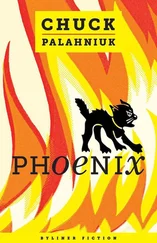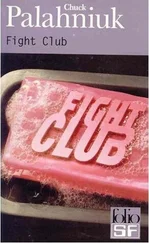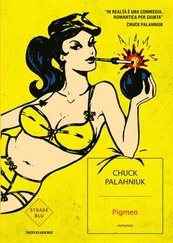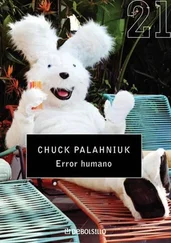Chuck Palahniuk - Fugatives & Refugees
Здесь есть возможность читать онлайн «Chuck Palahniuk - Fugatives & Refugees» весь текст электронной книги совершенно бесплатно (целиком полную версию без сокращений). В некоторых случаях можно слушать аудио, скачать через торрент в формате fb2 и присутствует краткое содержание. Жанр: Современная проза, на английском языке. Описание произведения, (предисловие) а так же отзывы посетителей доступны на портале библиотеки ЛибКат.
- Название:Fugatives & Refugees
- Автор:
- Жанр:
- Год:неизвестен
- ISBN:нет данных
- Рейтинг книги:5 / 5. Голосов: 1
-
Избранное:Добавить в избранное
- Отзывы:
-
Ваша оценка:
- 100
- 1
- 2
- 3
- 4
- 5
Fugatives & Refugees: краткое содержание, описание и аннотация
Предлагаем к чтению аннотацию, описание, краткое содержание или предисловие (зависит от того, что написал сам автор книги «Fugatives & Refugees»). Если вы не нашли необходимую информацию о книге — напишите в комментариях, мы постараемся отыскать её.
Fugatives & Refugees — читать онлайн бесплатно полную книгу (весь текст) целиком
Ниже представлен текст книги, разбитый по страницам. Система сохранения места последней прочитанной страницы, позволяет с удобством читать онлайн бесплатно книгу «Fugatives & Refugees», без необходимости каждый раз заново искать на чём Вы остановились. Поставьте закладку, и сможете в любой момент перейти на страницу, на которой закончили чтение.
Интервал:
Закладка:
"You've heard of Continental Kits?" he says. "I call this a 'Continental Breakfast Kit.'"
Eventually, the breakfast included real Hostess Twinkies, still wrapped but glued to the car. "I've found a Twinkie will last up to a year if the package isn't breached. And when our neighborhood has an ant problem, they're almost never on the Twinkies."
Since then, he says, "Me? I just love to stick crap on cars."
He uses only 100 percent silicone glue. GE and Dap brands are good. Sometimes he drills the car body and bolts things, but in Oregon that means leaks and mildew. "I've caulked the hell out of it, and I still get that delightful basement smell." When it comes to cleaning all those toys and appliances and bones and whatnot, well... "If you look close enough, you see—I don't. This is Oregon," he says. "Let the sky wash them!" Besides, he loves the different "mutations" each kind of plastic baby head or rubber nipple or crucifix goes through—oozing white crud or cracking—when exposed to years of auto exhaust and weather.
The upside is, "Most people I've talked to with art cars agree: You can get away with more with these cars than you can with a normal car. You can run stoplights. You can park across an intersection. When you reach a four-way stop, hardly anyone ever goes before you."
The downside includes: "Everybody wants to touch and wiggle things." They break off the trophy figures of little gold and silver people bowling, playing baseball, shooting, golfing. "Ninety-nine percent of the reactions are positive, but every once in a while you get a screamer who says, 'I bet that car has AIDS!'" He says, "You can't have a thin skin if you're going to drive these things. You have to expect some vandalism."
Another issue is the bees and hornets attracted to the colors and shiny mirrors so bright they might be a flower garden.
And crows. Chuck has a selection of wild animal lure tapes he got from a hunting store—wild pigs mating, coyotes, crows fighting, bobcats in heat—and he plays them over loudspeakers mounted outside each car. When he plays the crows tape, a flock of crows appears and follows the car like a noisy dark cloud. "I love the speakers," he says, "because you're mutating the environment from two blocks away." If you play the tape called "Red Fox in Distress," every dog in the area barks.
Living in Portland, this sort of acting out just seems natural. The whole city, he says, has a "small man complex."
Adding, "Portland makes up for its small size with its loud and obnoxious behavior."
Instead of animal tapes, he'll play bedwetting hypnosis records from the 1950s: ear-splitting recorded voices that tell every car in the parking lot or freeway, "We love you. We need you. If you wake up and have to go to the bathroom, you'll get up and come back to a nice, clean bed— and then we'll love you even more..."
At Christmas he blares mixes of bad Christmas music and calls it "drive-by caroling." Still, all this fucks with Chuck's own sense of reality. "Now when I hear crows, I think: 'Are those real crows?' When I hear a siren, I think: 'Is that a real cop or just someone like me?'"
Petroliana
Glenn Zirkle meant well. His idea was to find one old-time gasoline pump and restore it as a gift for his boss, Dick Dyke, at WSCO Petroleum. In 1982 he found Ins pump. In 1985 he found another. Since then, his collection of "Petroliana" has pretty much taken over the corporate offices at 2929 NW Twenty-ninth Avenue.
Now called the Historical Museum of Early Oil Days, it has at least one of everything you could possibly remember.
Glenn walks you through the earliest pumps, the "blind fuelers" of the 1910s, then the "visibles" of the 1910s through the 1920s. The earliest visible is a Wayne Pump model 492 "Roman or Greek Column pump" built to look like a fluted white column. It's fancy as hell, but any repairs meant rebuilding the whole thing—including the leather gaskets.
"I just started watching for the era of farms with old barns," he says. "They didn't go to town every day, so it was likely they had their own pumps."
"Visibles" provided gas from a ten-gallon, thirty-inch-tall glass tank perched at the top of the pump. First the fuel was pumped, by hand or power, up into the glass tank— like a cylindrical glass fish bowl—which was marked with levels for each gallon. This way the buyer could see the gas. Glenn says, "They'd want to feel like they were getting the amount they were paying for." Then the fuel was gravity-fed down into the car.
Next are the "clock face" pumps from the 1930s. On these, a big hand spins around the face of the pump once for each gallon, and a smaller hand moves slower, keeping track of the total number of gallons. From the 1940s through the 1960s there are the "three-wheel" computer pumps, with three places to record total sale in the days when gas prices ranged from 19 to 30 cents per gallon. After the 1960s higher gas prices led to the "four-wheel" computer pumps.
Besides the pumps, you'll find a hoard of drive-away premiums: toys and dishes, most of them painted with the red Mobil Oil Pegasus. Plus countless antique metal signs and rare items like the porcelain scallop shells that used to sit on each corner of an original Shell gas station roof. A few years ago, Glenn got his best buy when he tracked down a retired worker from the port fuel terminal. This man had taken a load of old service station signs, all of them the baked-porcelain kind that last forever. He'd hauled them up into the mountains around Vernonia to roof a shed with. When Glenn finally found the man, he'd just torn down the old shed and was hauling the antique signs to the dump. "He said, 'You'll pay me for those signs?'" Glenn says, "I wound up buying sixty-three assorted signs from him."
When visiting, keep in mind part of the building is still offices. WSCO Petroleum is the fuel distributor that owns the local Astro chain of gas stations, originally called "Tricky Dicky" after president Dick Dyke. Glenn says, "Nixon got in trouble, and away went that name." The company's logo, a grinning red-headed kid, is still around town.
The Spruce Goose
This airplane, dubbed a "flying lumberyard" by critics, flew just one time: November 2, 1947. Now Howard Hughes's "Spruce Goose" has been reassembled outside of Portland. For more details, check out www.sprucegoose. org, or drive by the Evergreen Aviation Museum at 3850 SE Three Mile Lane in McMinnville, Oregon. Phone: 503-434-4180.
Street-Legal Drag Racing
If you've got seat belts on your car and a fluid-overflow system for radiator boilovers, you can drag race in Portland. Go to the Portland International Raceway, Wednesday through Friday. For loud cars, up to 103 decibels, races go from 4:00 p.m. to 10:00 p.m. For cars up to 90 decibels, there's late-night racing until 1:00 A.m.
The track is in West Delta Park at 1940 N Victory Boulevard. Phone: 503-823-RACE. Check out the schedule at www.portlandraceway.com.
The Train Yards
Portland and railroads, it never stops. For years Portland boasted the worlds shortest railroad, running the couple miles from Milwaukie to the east end of the Marquam Bridge. It was called Samtrak because Dick Samuels maintained the rolling stock and his wife, Dawn, was the engineer.
Before that, local kids used to play on an ancient steam locomotive that stood in a flower bed in front of Union Station—until Hollywood property scouts bought the engine and restored it as the "Hooterville Cannonball" for the television series Petticoat Junction.
For a look at vintage trains, take SE Seventeenth Avenue, just north of Holgate Boulevard, and turn east on Center Street. Go one block until the street dead-ends at a railroad crossing. Cross the tracks into a large gravel parking lot filled with trucks. Bearing right (southeast), pass through the gravel lot until you come to another railroad crossing. Just beyond that is the partial roundhouse with a small white sign that says Brooklyn. Park along the one-story building adjacent to the roundhouse. A heavy red door right under the Brooklyn sign lets you inside.
Читать дальшеИнтервал:
Закладка:
Похожие книги на «Fugatives & Refugees»
Представляем Вашему вниманию похожие книги на «Fugatives & Refugees» списком для выбора. Мы отобрали схожую по названию и смыслу литературу в надежде предоставить читателям больше вариантов отыскать новые, интересные, ещё непрочитанные произведения.
Обсуждение, отзывы о книге «Fugatives & Refugees» и просто собственные мнения читателей. Оставьте ваши комментарии, напишите, что Вы думаете о произведении, его смысле или главных героях. Укажите что конкретно понравилось, а что нет, и почему Вы так считаете.




